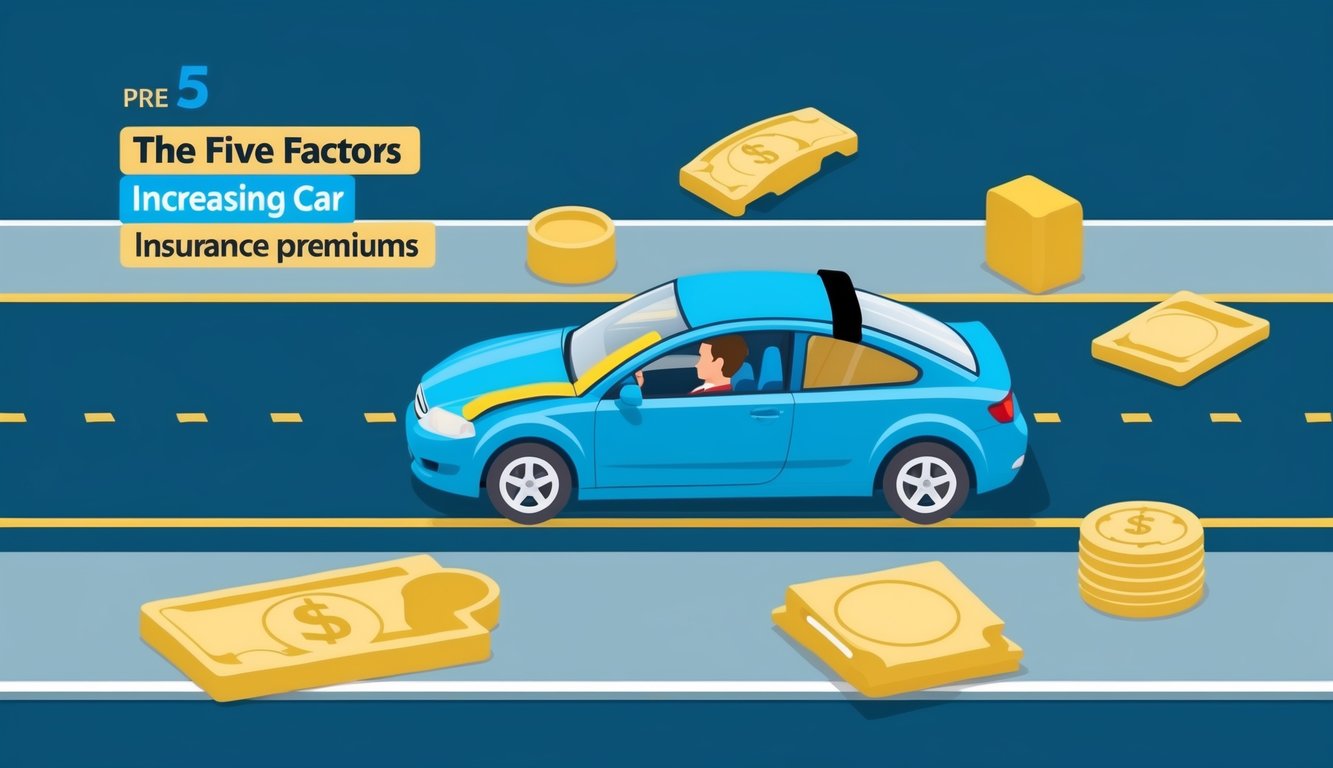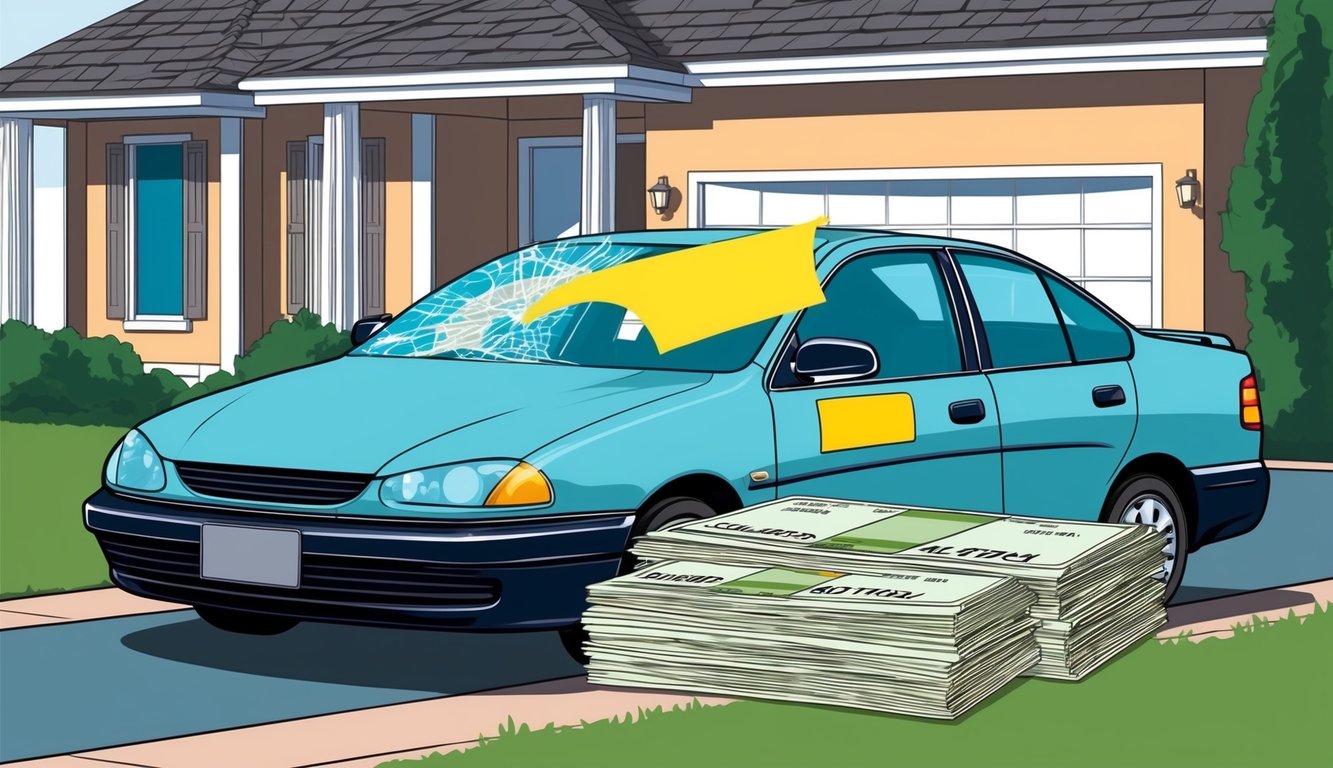Car insurance premiums can fluctuate for various reasons, often leaving drivers puzzled about sudden increases.
Your actions and choices significantly impact your rates.
Understanding these influences empowers you to make informed decisions that could help keep your premiums in check.
By identifying and addressing key behaviors that may be driving up your car insurance costs, you can potentially reduce your financial burden and find more affordable coverage options. From driving habits to policy choices, several factors within your control can affect what you pay for auto insurance.
Let’s explore five common actions that might be causing your premiums to rise and what you can do about them.
1) Speeding Tickets
Speeding tickets can significantly impact your car insurance premium.
When you receive a citation for exceeding the speed limit, insurance companies view you as a higher risk driver.
In most cases, speeding tickets affect car insurance rates.
A single ticket could increase your insurance cost by hundreds of dollars annually.
The average car insurance rate increase for drivers with a speeding ticket is about 24%, or nearly $380 more per year.
This substantial jump in premiums can strain your budget over time.
Insurance companies typically keep speeding tickets on your record for 3-5 years.
During this period, you’ll likely face higher rates.
The good news is that the effect of a ticket diminishes over time, especially if you maintain a clean driving record afterward.
You can take steps to mitigate the impact of a speeding ticket on your insurance.
Consider taking defensive driving courses, which may help reduce your rates.
Shopping around for quotes from different insurers can also help you find more competitive rates.
To avoid future rate increases, always obey posted speed limits.
Use cruise control on highways to maintain a consistent speed.
Be extra cautious in areas known for speed traps or frequent traffic enforcement.
Remember, speeding tickets not only affect your insurance rates but also put your safety and the safety of others at risk.
By driving responsibly, you can keep your premiums low and protect yourself on the road.
2) Driving Without a Seatbelt

Failing to buckle up can have serious consequences for your car insurance premium.
Insurance companies view seatbelt use as a key indicator of responsible driving behavior.
If you’re caught driving without a seatbelt, you may receive a traffic citation.
This violation can be reported to your insurance provider, potentially leading to an increase in your premium.
Seatbelts significantly reduce the risk of severe injuries and fatalities in accidents.
Seat belts save an estimated 14,955 lives annually and could save even more if all drivers used them consistently.
Insurance companies factor in this safety benefit when calculating premiums.
By not wearing a seatbelt, you’re signaling to insurers that you’re taking unnecessary risks on the road.
Some insurers offer discounts for consistent seatbelt use.
By failing to buckle up, you may be missing out on these potential savings.
Remember, seatbelt laws vary by state, but most require drivers and passengers to wear them.
Repeated violations can lead to more severe penalties and higher insurance costs.
To protect yourself financially and physically, always wear your seatbelt.
It’s a simple habit that can save you money on insurance and potentially save your life in an accident.
3) Parking Violations
You might think parking tickets are harmless, but they can impact your car insurance rates.
While a single parking ticket typically won’t affect your premium, multiple violations or unpaid fines can lead to increased costs.
Insurance companies view repeated parking infractions as a sign of risky behavior.
This perception can result in higher premiums when it’s time to renew your policy.
Unpaid parking tickets can be particularly problematic.
If you neglect to pay, the fine may be sent to a collections agency.
This action can negatively affect your credit score, which many insurers use to calculate premiums.
Some cities report parking violations to the Department of Motor Vehicles.
If these appear on your driving record, insurance companies may consider them when determining your rates.
To avoid potential rate increases, pay your parking tickets promptly.
Make an effort to follow parking rules and regulations in your area.
Being mindful of where and how you park can help keep your insurance costs down.
If you receive a parking ticket, don’t ignore it.
Address the issue quickly to prevent it from escalating and potentially impacting your insurance premium.
Remember, responsible parking habits contribute to maintaining lower insurance rates.
4) Lapsed Insurance Coverage
Letting your car insurance coverage lapse can significantly increase your premiums.
A lapse occurs when you have a period without active insurance, even if it’s just for a day.
Insurance companies view lapses as a sign of increased risk.
They assume you may have been driving uninsured during that time, which is illegal in most states.
The impact on your rates depends on the length of the lapse.
Short lapses under 30 days typically result in an 8% rate increase, while longer lapses can lead to much steeper hikes.
For lapses exceeding 30 days, you might face premium increases of up to 35%.
Some insurers may even refuse to cover you if you’ve had a significant lapse in coverage.
To avoid these rate hikes, maintain continuous coverage.
If you’re selling a car or temporarily not driving, consider getting a non-owner policy to prevent a lapse.
If you do experience a lapse, be prepared to shop around for new coverage.
Different insurers may be more forgiving of brief lapses, so comparing quotes can help you find the best rates.
5) Frequent Claims

Making multiple insurance claims in a short period can significantly impact your car insurance premium.
Insurance companies view frequent claims as a sign of higher risk.
Each time you file a claim, your insurer reassesses your risk profile.
Multiple claims suggest you’re more likely to file future claims, prompting insurers to raise your rates.
Even minor claims can affect your premium.
Small, frequent claims may lead to larger rate increases than a single major claim.
Consider handling small repairs out-of-pocket.
This approach can help maintain a clean claims history and potentially save you money in the long run.
Some insurers offer claim forgiveness programs.
These programs may prevent your first claim from affecting your rates, but subsequent claims will likely still impact your premium.
Be mindful of your claim frequency.
Try to limit claims to significant incidents where the cost of repair substantially exceeds your deductible.
Remember, your claims history typically affects your rates for three to five years.
Making fewer claims during this period can help keep your premiums lower.
Understanding Car Insurance Premiums
Car insurance premiums are influenced by various factors and calculated using complex formulas.
Knowing what impacts your rates can help you make informed decisions to potentially lower your costs.
What Affects Your Premiums?
Your driving record plays a crucial role in determining your premium.
Accidents and traffic violations can significantly increase your rates.
The type of vehicle you drive also matters.
Expensive cars or those with high theft rates typically cost more to insure.
Your location impacts your premium too.
Urban areas often have higher rates due to increased accident and theft risks.
Age and gender are factors as well, with younger drivers and males generally paying more.
Credit score can influence your rates in many states.
Better credit often translates to lower premiums.
Your coverage choices, including deductibles and policy limits, directly affect your costs.
How Premiums Are Calculated
Insurance companies use complex algorithms to calculate premiums.
They start by assessing your risk profile based on factors like driving history, age, and location.
This data is compared to statistical models to predict the likelihood of you filing a claim.
Insurers also consider economic factors such as inflation and repair costs.
Rising prices for vehicle parts and labor contribute to higher premiums across the board.
The frequency and severity of accidents in your area are factored in as well.
Your chosen coverage levels are then applied to this risk assessment.
Higher coverage limits and lower deductibles increase your premium.
Discounts for things like safe driving or bundling policies are subtracted to arrive at your final rate.
Common Myths About Car Insurance

Car insurance can be confusing, leading to several widespread misconceptions.
Let’s debunk two common myths that might be costing you money or leaving you with inadequate coverage.
Red Cars Cost More to Insure
Contrary to popular belief, the color of your car doesn’t affect your insurance premium.
Insurance companies don’t consider car color when calculating rates.
They focus on factors like the make, model, age, and safety features of your vehicle.
What matters more is the car’s:
- Safety rating
- Theft rate
- Repair costs
- Engine size
Your driving record, age, and location have a much bigger impact on your premium than your car’s color.
So feel free to choose that sleek red model without worrying about higher insurance costs.
Comprehensive Coverage Is Always Necessary
Comprehensive coverage provides valuable protection, but it’s not always essential for every driver.
This type of insurance covers non-collision related damages, such as theft, vandalism, or natural disasters.
Comprehensive coverage may not be cost-effective if:
- Your car is older and has a low resale value
- You have savings to replace your vehicle if needed
- You live in a low-risk area for theft or natural disasters
Evaluate your specific situation to determine if comprehensive coverage is worth the extra cost.
Consider factors like your car’s value, your financial situation, and your risk tolerance when deciding on coverage options.






